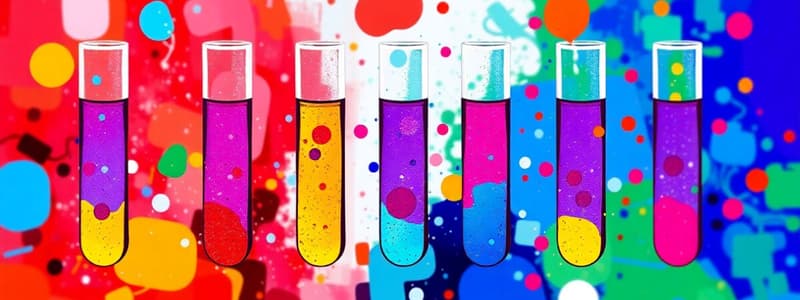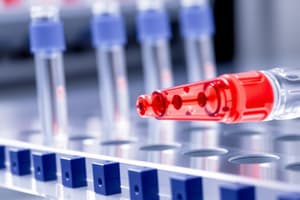Podcast
Questions and Answers
What is the primary purpose of ELISA in the context of detecting antibodies or antigens?
What is the primary purpose of ELISA in the context of detecting antibodies or antigens?
- To amplify the concentration of antibodies in a sample.
- To measure the electrical conductivity of a solution.
- To detect the presence of antibodies or antigens in a patient specimen. (correct)
- To isolate and purify specific types of cells from a blood sample.
The sensitivity of ELISA, referring to its ability to detect even small amounts of a substance, is primarily attributed to what component?
The sensitivity of ELISA, referring to its ability to detect even small amounts of a substance, is primarily attributed to what component?
- The enzyme used as a reporting chemical. (correct)
- The specificity of the antibodies used in the assay.
- The blocking buffer used to prevent non-specific binding.
- The use of automated equipment.
What role do immunoglobulins (Ig) play in the human body?
What role do immunoglobulins (Ig) play in the human body?
- They transport oxygen throughout the bloodstream.
- They facilitate digestion and nutrient absorption.
- They regulate blood sugar levels.
- They identify and neutralize foreign objects, such as viruses. (correct)
What triggers the production of antibodies (Ab) in the body?
What triggers the production of antibodies (Ab) in the body?
In ELISA, what is the role of the 'analyte'?
In ELISA, what is the role of the 'analyte'?
Which of the following is a common label used in ELISA to tag the antibody?
Which of the following is a common label used in ELISA to tag the antibody?
What is the function of the blocking buffer in ELISA?
What is the function of the blocking buffer in ELISA?
What is the purpose of the wash buffer in ELISA?
What is the purpose of the wash buffer in ELISA?
Which instrument is used to view and quantify the results of an ELISA assay?
Which instrument is used to view and quantify the results of an ELISA assay?
In a standard ELISA protocol, what is the purpose of coating the Ag onto the microplate?
In a standard ELISA protocol, what is the purpose of coating the Ag onto the microplate?
In the context of ELISA, what is meant by a 'chromogenic' detection format?
In the context of ELISA, what is meant by a 'chromogenic' detection format?
What happens when a fluorophore absorbs light in a Fluorescent Immunoassay?
What happens when a fluorophore absorbs light in a Fluorescent Immunoassay?
In Chemiluminescent Immunoassay, what causes the emission of light?
In Chemiluminescent Immunoassay, what causes the emission of light?
What is the key difference between chemiluminescent immunoassay and chromogenic immunoassay?
What is the key difference between chemiluminescent immunoassay and chromogenic immunoassay?
In a direct ELISA format, which of the following is true?
In a direct ELISA format, which of the following is true?
In which ELISA format is a secondary antibody used?
In which ELISA format is a secondary antibody used?
In which application is direct ELISA commonly utilized?
In which application is direct ELISA commonly utilized?
What is a major disadvantage of direct ELISA compared to indirect ELISA?
What is a major disadvantage of direct ELISA compared to indirect ELISA?
Which of the following is an advantage of using indirect ELISA over direct ELISA?
Which of the following is an advantage of using indirect ELISA over direct ELISA?
What is the primary purpose of capture ELISA (Sandwich ELISA)?
What is the primary purpose of capture ELISA (Sandwich ELISA)?
In IgM capture ELISA, what is immobilized on the solid phase?
In IgM capture ELISA, what is immobilized on the solid phase?
What is the purpose of using anti-IgG (Fc portion) in the reagent mix during IgM assays?
What is the purpose of using anti-IgG (Fc portion) in the reagent mix during IgM assays?
How does rheumatoid factor (RF) interfere with ELISA results?
How does rheumatoid factor (RF) interfere with ELISA results?
What is a common method to remove rheumatoid factor (RF) interference in ELISA assays?
What is a common method to remove rheumatoid factor (RF) interference in ELISA assays?
In competitive ELISA, what happens when there is a high concentration of the target antigen in the sample?
In competitive ELISA, what happens when there is a high concentration of the target antigen in the sample?
Which type of antibody is often used as a capture antibody to pull down as much antigen as possible?
Which type of antibody is often used as a capture antibody to pull down as much antigen as possible?
What characteristic of monoclonal antibodies allows for fine detection and quantification of small differences in antigens?
What characteristic of monoclonal antibodies allows for fine detection and quantification of small differences in antigens?
What is the MOST appropriate first step in planning an IgM ELISA assay?
What is the MOST appropriate first step in planning an IgM ELISA assay?
In comparing monoclonal with polyclonal antibodies, which is BEST for general capture of antigen?
In comparing monoclonal with polyclonal antibodies, which is BEST for general capture of antigen?
In an ELISA where the enzyme label is linked indirectly via a secondary antibody, what does the primary antibody recognize?
In an ELISA where the enzyme label is linked indirectly via a secondary antibody, what does the primary antibody recognize?
In ELISA, what is the function of the stop solution?
In ELISA, what is the function of the stop solution?
In the context of antigens, what differentiates a 'self' antigen from a 'non-self' antigen?
In the context of antigens, what differentiates a 'self' antigen from a 'non-self' antigen?
What is the correct order of steps in a simple ELISA protocol after coating the Ag onto the microplate?
What is the correct order of steps in a simple ELISA protocol after coating the Ag onto the microplate?
In a competitive ELISA, how does the presence of a high concentration of the target antigen in the sample affect the signal produced?
In a competitive ELISA, how does the presence of a high concentration of the target antigen in the sample affect the signal produced?
Which ELISA format is most suitable when the antigen does not require purification?
Which ELISA format is most suitable when the antigen does not require purification?
What property of polyclonal antibodies makes them useful as capture antibodies?
What property of polyclonal antibodies makes them useful as capture antibodies?
What is the primary advantage of using monoclonal antibodies?
What is the primary advantage of using monoclonal antibodies?
High quality solid phase material, why is it used?
High quality solid phase material, why is it used?
Flashcards
ELISA Definition
ELISA Definition
A biochemical technique used to detect antibodies or antigens in a patient specimen.
Antibodies Definition
Antibodies Definition
Proteins in the blood used by the immune system to identify and neutralize foreign objects such as viruses.
Antigen Definition
Antigen Definition
A protein that, when introduced into the body, stimulates the production of an antibody
Immunoassay
Immunoassay
Signup and view all the flashcards
Analyte
Analyte
Signup and view all the flashcards
Enzyme (in ELISA)
Enzyme (in ELISA)
Signup and view all the flashcards
Substrate (in ELISA)
Substrate (in ELISA)
Signup and view all the flashcards
Wash Buffer
Wash Buffer
Signup and view all the flashcards
Stop Solution (in ELISA)
Stop Solution (in ELISA)
Signup and view all the flashcards
Positive/Negative Controls
Positive/Negative Controls
Signup and view all the flashcards
Radio-immunoassay
Radio-immunoassay
Signup and view all the flashcards
Chromogenic Detection
Chromogenic Detection
Signup and view all the flashcards
Fluorescent Immunoassay
Fluorescent Immunoassay
Signup and view all the flashcards
Chemiluminescent Immunoassay
Chemiluminescent Immunoassay
Signup and view all the flashcards
Direct ELISA
Direct ELISA
Signup and view all the flashcards
Indirect ELISA
Indirect ELISA
Signup and view all the flashcards
Capture ('Sandwich') ELISA
Capture ('Sandwich') ELISA
Signup and view all the flashcards
Competitive ELISA
Competitive ELISA
Signup and view all the flashcards
IgM µ-Capture ELISA
IgM µ-Capture ELISA
Signup and view all the flashcards
Monoclonal Antibodies
Monoclonal Antibodies
Signup and view all the flashcards
Polyclonal Antibodies
Polyclonal Antibodies
Signup and view all the flashcards
Solid support for ELISA
Solid support for ELISA
Signup and view all the flashcards
Conjugate
Conjugate
Signup and view all the flashcards
Blocking buffer
Blocking buffer
Signup and view all the flashcards
Study Notes
ELISA Basics
- ELISA stands for Enzyme-Linked Immunosorbent Assay and is a laboratory method
- It detects the presence of an antibody or antigen in a patient specimen
- ELISA tests can be qualitative or quantitative
- ELISAs can be performed manually or automated
Key Components
- Antibodies (Ab): Immunoglobulins are gamma globulin proteins in blood used by the immune system to identify and neutralize foreign objects like viruses
- Antigens (Ag): Proteins that, when introduced into the body, stimulate the production of antibodies
- Immunoassay: A lab technique using the binding between an antigen and its corresponding antibody to identify and quantify specific antigens or antibodies in a sample
- Analyte: The specimen being analyzed, which can be either an antibody or an antigen in ELISA tests
Solid Phase
- ELISA utilizes a solid phase component
- Typically a 96-well plate, magnetic microparticles, or beads
Key Materials
- Ag/capture Ab: Antigen or capture antibody is attached to the solid phase.
- Patient specimen: The sample from the patient being tested.
- Conjugate: An enzyme-labeled anti-species detector antibody.
- Substrate: A chemical compound converted by an enzyme to produce a detectable chromogenic or fluorescent signal.
- Blocking buffer: Casein or BSA is used to block nonspecific adsorption of proteins to the solid phase.
- Wash buffer: Used to remove unbound substances.
- Stop solution: Halts the enzyme's action on the substrate, preventing excessively bright colors that a spectrophotometer cannot read.
- Controls: Positive and negative controls ensure the validity of the assay.
- Spectrophotometer: An optical device used to view results by reading specific wavelengths for specific colors produced by the enzyme/substrate combinations used.
Enzyme Labels
- A detection enzyme can be linked directly to the primary antibody
- The primary antibody can be linked indirectly to a secondary antibody
- The enzyme can be linked to a protein like streptavidin if the primary antibody is biotin-labeled
- Horseradish Peroxidase (HRP) and Alkaline Phosphatase (AP) are common enzyme labels
ELISA Protocols
- Antigen is coated onto a microplate
- Protein adsorption is allowed, and unoccupied sites are blocked with a neutral protein
- Antibody solution is added to each well
- HRP or AP conjugated secondary antibody is added, and a colorimetric reaction is developed with an appropriate substrate
- Absorbance is read using a spectrophotometer with an appropriate filter
- Relative antigen levels are quantified.
Detection Formats
- Radio-Immunoassay: Uses a radioactively labeled detector antibody, emitting gamma radiation
- Can be unstable and hazardous
- Chromogenic: Uses a colored reaction product that absorbs light in the visible range
- The substrate becomes colored when catalyzed by an enzyme, and the optical density is proportional to the analyte amount
- Fluorescent Immunoassay: Involves an enzyme and substrate that produce a fluorescent reaction product when excited by a specific wavelength of light
- Fluorophores absorb light, raising the energy level and causing fluorescence upon return to the baseline state
- Mini-Vidas platform is used for this method (biomeriux, France)
- Offers higher sensitivity and a wider dynamic range compared to chromogenic assays
- Chemiluminescent Microparticle Immunoassay: Employs an enzyme that converts a substrate into a reaction product that emits photons of light
- Acridinium Ester is conjugated to the antibody or antigen, resulting in chemiluminescence when exposed to hydrogen peroxide and sodium hydroxide
- Architect is used for this method (Abbott, USA)
- Higher sensitivity, a wider dynamic range and lower background interference
ELISA Formats
- Direct
- Indirect
- Capture (Sandwich)
- Competition/Inhibition
Direct ELISA
- An antigen-specific antibody is attached to a solid phase
- A patient specimen is added
- Enzyme-labeled antibody (conjugate) is added to the sample
- Chromogenic substrate is added, and the presence of enzyme induces a color change
Indirect ELISA
- An antigen or sample is added to the plate
- Blocking buffer is applied to block remaining protein-binding sites
- A suitable primary antibody is added
- A suitable secondary antibody – HRPO conjugate is then added, it binds to the primary antibody
- TMB substrate is added and converted by HRPO to a detectable form
Direct vs. Indirect Comparison
- Direct ELISA uses a labeled primary antibody that reacts directly with the antigen
- Suited for use with antigen directly immobilized on a solid phase or in a capture assay format
- Not widely used in ELISA but common in immunohistochemical staining of tissues and cells.
- Indirect ELISA uses a labeled secondary antibody
- Most popular ELISA format: the secondary antibody has specificity for the primary antibody
Advantages of Direct ELISA
- Quick
- Only one antibody is needed
- Eliminates cross-reactivity of the secondary antibody
Disadvantages of Direct ELISA
- Immunoreactivity of the primary antibody altered by labeling with enzymes or tags
- Labeling primary antibodies for each specific ELISA system is time-consuming and expensive
- No flexibility in choice of primary antibody label from one ELISA to another
- Minimal signal amplification is achieved
Advantages of Indirect ELISA
- Wide variety of labeled secondary antibodies commercially available
- Many primary antibodies for one species can use the same labeled secondary antibody detection
- Maximum immunoreactivity of the primary antibody is retained if it is not labelled
- Increased Sensitivity
- Each primary antibody contains several epitopes
- Various visualization markers can be used with the same primary antibody
Disadvantages of Indirect ELISA
- Cross-reactivity may occur with a secondary antibody, causing a nonspecific signal
- Requires an extra incubation step in ELISA
Capture ELISA
- An antibody specific for IgG or IgM is attached to a solid phase
- Patient specimen with possible high IgM is added
- Specific antigen is added
- Enzyme-labeled antibody (conjugate) is added
- Chromogenic substrate is added, and presence of the enzyme induces a color change
IgM μ-Capture ELISA
- An antibody directed to the human IgM (μ- heavy chain portion) is immobilized on a solid phase instead of using a specific antigen
- Anti-μ antibodies are highly IgM specific
- They are directed to the conserved region of the μ heavy chain unique to IgM
- IgM in the patient specimen is captured by these anti-μ antibodies
- Competing IgG and non-IgM RF are not captured
- Washing removes all unbound IgG and immune complexes
- Specific antigen and an enzyme-conjugated antibody specific to that antigen are added to detect bound IgM
Non-Specific Reactions
- Mechanisms include variety of ways in which it is non-specific
- Use high-quality solid-phase material and stringent washing techniques
- Prevent the non-specific binding of immunoreactants to the solid phase
- Use purified or monoclonal antibodies
- prevent non-specific reactions
- Some specimens yield false positives from non-specific antiglobulin activity directed against other immunoreactants
- Reduce antiglobulin activity by adding a mild reducing agent, such as 20% N-acetyl-cysteine
- This addresses the presence of IgM rheumatoid factor (RF)
IgM Assay Challenges
- Several factors interfere with the detection of IgM
- Must be removed or neutralized to ensure accurate results
- Ag-specific IgG from previous or latent infection competes with Ag-specific IgM from a new infection for capture Ag
- Prevents the formation of a sandwich = false-negative results
- Anti-IgG (Fc portion) may be included to bind IgG and be removed during the wash step
Rheumatoid Factor
- Rheumatoid factor is an autoimmune antibody; predominantly IgM
- IgM targets the Fc region of IgG
- RF crosslinks interfering = false positive
- Removal of IgG prevents false positives
- It may cause binding of the RF to labeled IgG, yielding in false negatives
- Can use commercial adsorbents to remove the RF
- Modify the assay by using an IgM μ-capture ELISA is an alternative approach
Competitive ELISA
- High specificity can be achieved using two antibodies – the antigen is specifically captured
- Suitable for complex specimens because no protein purification is required prior to measurement
- Direct and indirect detection methods can be used to provide flexibility and sensitivity
Monoclonal vs Polyclonal
- Monoclonal Antibodies recognize a single epitope
- Allows fine detection and quantification of small differences in antigens
- Polyclonal Antibodies are often used as capture antibodies to pull down as much antigen as possible
Studying That Suits You
Use AI to generate personalized quizzes and flashcards to suit your learning preferences.




